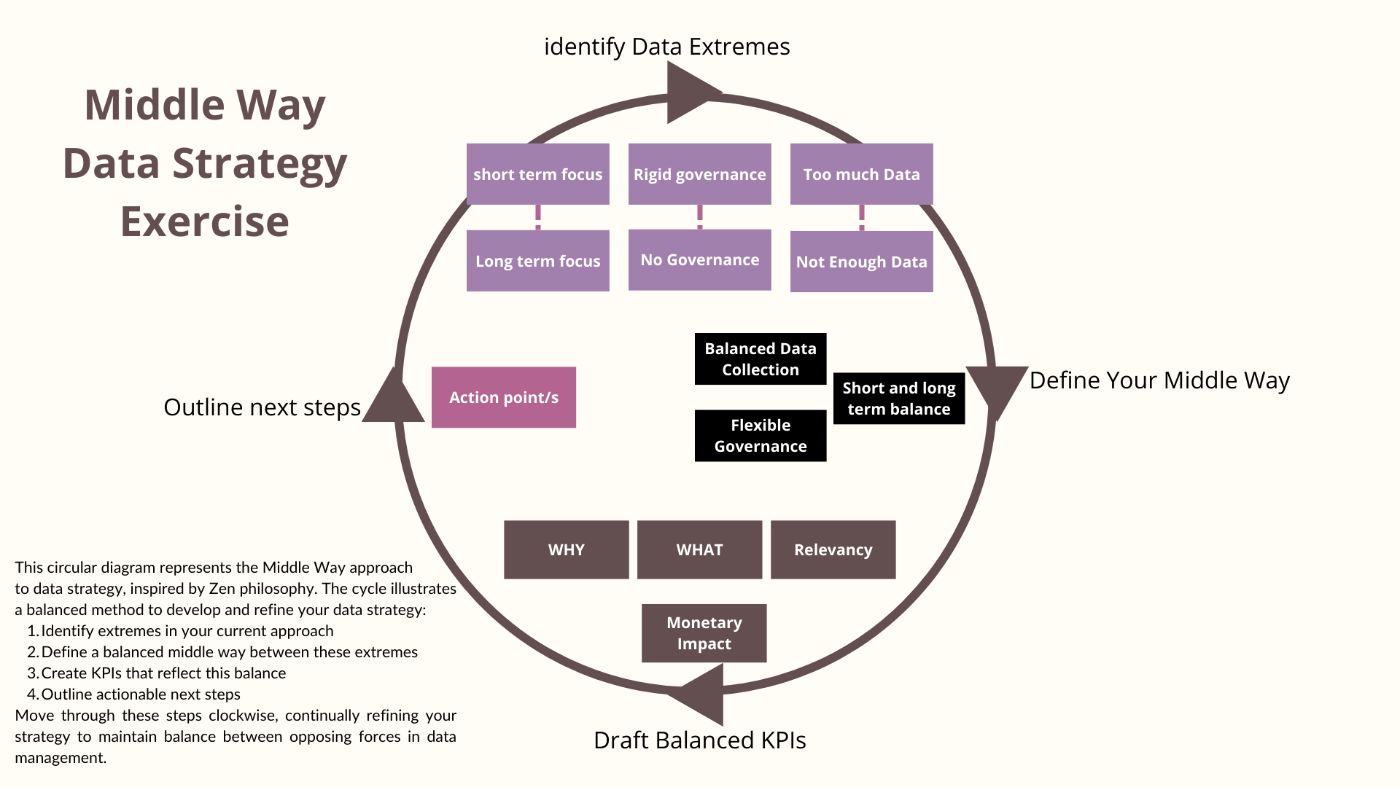and the distribution of digital products.
Why Data Strategies Fail in Companies – And How CEOs Can Fix Them
A solid data strategy is critical for business success in today's data-driven world. Yet, many companies struggle to make their data strategies work, leading to missed opportunities, wasted resources, and stagnated growth. What's going wrong, and how can CEOs fix the problem?

\ This article explores the common pitfalls of data strategies and provides practical steps for CEOs to align their teams, set clear priorities, and ensure their data strategy delivers real business impact.
Understanding Data Vision, Strategy, and ProductsBefore discussing why data strategies fail, it’s crucial to distinguish between data vision, data strategy, and data products. Each of these serves different roles and requires different leadership approaches.
Data VisionThe data vision is the long-term aspiration for how data will be leveraged within the company, and it serves as the North Star guiding the organization's data initiatives.
\ It should outline:
- How different functions will interact with data
- The data platform architecture
- The expected future size of the data
- Integration with emerging technologies (like LLMs)
\ Your data vision should inspire both the data team and the business stakeholders. It’s a strategic narrative that paints a picture of where the organization is headed in terms of data capabilities over the next 3-5 years.
\ Key metrics to measure its success include:
- Data Availability: How accessible and ready-to-use is the data for decision-making?
- Data Costs: Is the investment in data infrastructure yielding a healthy ROI? This includes efficiency gains or revenue growth from data initiatives.
While the data vision is aspirational, the data strategy is operational and action-driven. It defines the specific steps needed to achieve the vision. This includes:
- Establishing KPIs and datasets that will inform decisions
- Creating dashboards for business and operational health
- Standardizing how KPIs are communicated across the organization
\ The data strategy links business goals to measurable data-driven outcomes and ensures accountability.
Metrics to track for success are:
Data Utilization: What percentage of collected data is actively being used in decision-making?
Data ROI: Are data initiatives generating financial returns or improving operational efficiency?

Data products are the tangible outputs of the data strategy. These include:
- Key KPIs used across the business
- Machine learning and AI models for automation and insights
- Actionable datasets for different business units
\ To foster a product-oriented approach to data, treat data products like any other product—defined by lifecycle management, user feedback, and iterations.
\ Success is measured by:
Data Relevancy: How aligned are the data products with the needs of their users?
Data ROI: Are these products driving value and outcomes?

CEOs need to steer and align these three elements:
- Data Vision: Ensure it aligns with long-term business goals and fosters innovation.
- Data Strategy: Guide the prioritization of KPIs and ensure all departments align with business objectives.
- Data Products: Promote a product mindset within data teams and ensure data products are driving measurable impact.
One of the most significant challenges arises from a disconnect between executives and data teams. While data professionals focus on practical solutions—gathering actionable data and implementing measurable KPIs—executives often take a broader, more abstract approach. This gap creates confusion, with management discussing visions or high-level concepts while data teams are asking, "What exactly do we need to measure and how?"
The FixCEOs must play a crucial role in bridging this gap by fostering open and focused discussions between both groups. It's essential to shift conversations away from abstract visions or technological tools and towards specific, actionable KPIs that align with the company's immediate objectives.
\ Example: At a rapidly growing e-commerce company, the CEO implemented weekly "data alignment" meetings. These sessions brought together executives and data team leads to discuss specific, measurable goals for the quarter, such as "Increase customer retention rate by 5% through personalized product recommendations."
\
2. Stop Focusing on Technology and Principles The ProblemMany companies get lost in endless debates about the latest technologies or lofty data principles, which creates confusion and delays. Executives often want to discuss the future of their data landscape five years from now or the technical architecture that will support it. But without clear, immediate objectives, these discussions lack direction.
The FixInstead of focusing on tools and abstract principles, CEOs should center the conversation around clear KPIs that drive business goals. What does the company need to achieve right now? How will we measure our success in customer acquisition, retention, or product growth?
\ Example: A SaaS startup shifted its focus from debating cloud platforms to defining key metrics like "Reduce customer churn by 2% month-over-month" and "Increase feature adoption rate by 10% for new users." This clarity allowed the data team to choose appropriate tools and methods to achieve these specific goals.
\
3. Set Clear Expectations and be AccountableThe Problem
Often, there is no clear ownership of KPIs, leaving data teams without direction. When a KPI moves—whether up or down—teams are unsure who is responsible or what actions need to be taken.
The FixEvery KPI must have a single, accountable owner who can manage and report on its performance. This person should know exactly what needs to happen when a KPI changes. CEOs must ensure this ownership is clear and enforced, assigning specific roles to ensure nothing falls through the cracks.
\ Example: A B2B software company implemented a "KPI Ownership Matrix," assigning each core metric to a specific department head. The head of customer success, for instance, became responsible for the "Net Promoter Score" KPI, with clear action plans for both positive and negative movements.
4. Measure Data ROI and Utilization The ProblemIt's easy for companies to fall into the trap of collecting data for the sake of it, without understanding the real value. The result is a bloated data warehouse filled with unused information, a lot of DATA NOISE, wasting resources, and complicating decision-making.
The FixCEOs should push for a strong focus on Data ROI and Data Utilization:
- Data ROI: What tangible value does the data we're collecting provide? What is the return on investment for storing and analyzing it?
- Data Utilization: Of all the data we're collecting, how much is being used?
\ Example: A retail chain implemented a quarterly "Data Audit" process. They found that 60% of their collected customer data hadn't been accessed in over a year. By focusing on the most utilized and high-ROI data points, they streamlined their data collection, reduced storage costs by 30%, and improved the speed of their analytics processes.
\
5. Don't Put Data Strategy Under the CTO The ProblemWhile CTOs often play a crucial role in data management, assigning data strategy solely to them can limit its effectiveness. By placing data strategy under the direct supervision of executives who are deeply invested in business outcomes, such as the CEO, CFO, CPO, or CMO, organizations can ensure that data initiatives are aligned with strategic goals and drive tangible value.
The FixInstead, the responsibility should lie with those closest to the business outcomes—such as the Chief Product Officer (CPO) or Chief Marketing Officer (CMO)—who are the primary consumers of data, and I dare say even under the CEO's direct supervision.
\ Example: A media company shifted its data strategy ownership from the CTO to the CEO, who worked closely with the CMO and CPO on defining what matters for him and how he will measure their function's success. This led to more business-aligned data initiatives, which can result in improved content engagement metrics.
\
6. Treat Data Strategy as a Product The ProblemCompanies often treat data as an afterthought—something to be collected and stored without a clear plan for how it will be used. This leads to a reactive approach rather than a proactive strategy.
The FixCEOs must advocate for a product mentality in data strategy. Data should be treated like a product—built, iterated on, and continuously improved.
\ Example: A fintech startup adopted a "Data Product Management" approach, assigning product managers to key data initiatives. They implemented sprint cycles for data projects, regular user feedback sessions, and iterative improvements. This approach led to increased adoption of data-driven tools across the organization.
\
Actionable Steps for CEOsDraft a Data Strategy Framework
List key KPIs for tracking performance and link them to business outcomes.
Define the potential monetary impact and alignment with strategic objectives.
\
Implement Regular Data Alignment Meetings
Hold bi-weekly sessions where executives and data teams discuss specific KPIs and progress toward business objectives.
\
Establish KPI Ownership
Create a matrix that assigns ownership of each KPI to a department leader, with clear accountability.
\
Conduct Data Audits
Review which data is being used and its ROI. Eliminate irrelevant data to reduce noise and optimize resources.
\
Adopt Data Product Management Practices
Treat data initiatives like products. Assign product managers to key data outputs and adopt iterative cycles.
As a CEO, your role in shaping and driving data strategy is crucial. By understanding the distinctions between data vision, strategy, and products, and by taking an active role in their development, you can transform your organization's approach to data.
Remember:
- Focus on business outcomes, not just technology
- Ensure clear ownership and accountability for data initiatives
- Regularly measure and optimize data ROI and utilization
- Foster a data-driven culture across all levels of the organization
\ By embracing these principles and taking the actionable steps outlined in this article, you can lead your company to success in the data-driven future. Start with the 60-minute exercise to draft your data strategy framework, and build from there. The journey to effective data leadership starts with you.
\ You can find the 60 minutes exercise in here.

\
- Home
- About Us
- Write For Us / Submit Content
- Advertising And Affiliates
- Feeds And Syndication
- Contact Us
- Login
- Privacy
All Rights Reserved. Copyright , Central Coast Communications, Inc.